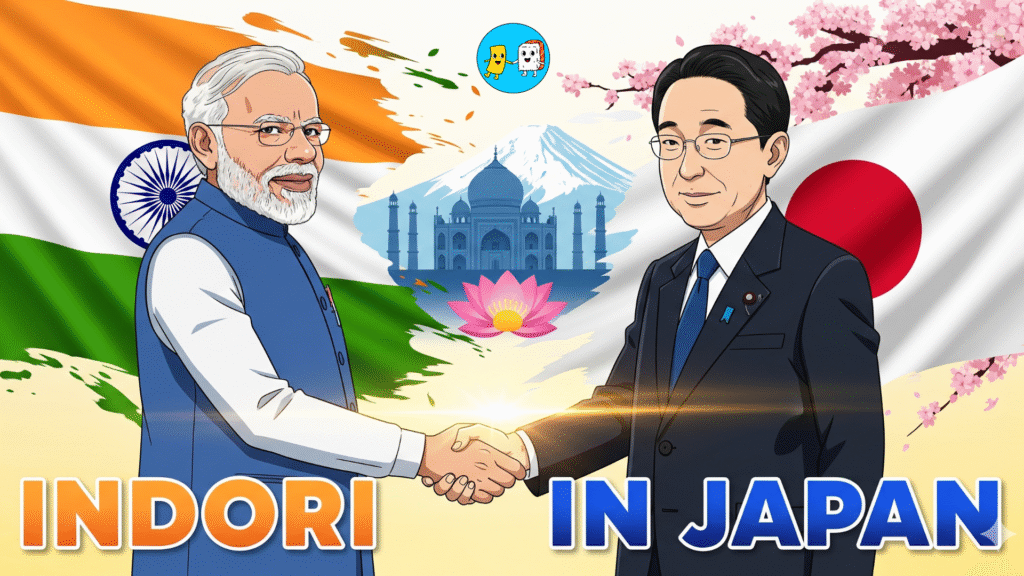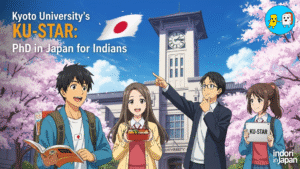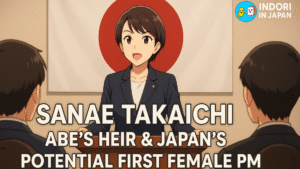Japan Welcomes 5,00,000 Indians: A New Era of India-Japan Partnership
皆さん、こんにちは!(Hello everyone!)
Hey everyone, Akash here, coming to you from Tokyo! And guys, I have some HUGE news. If you’ve been following me, watching my videos, or reading my blog, you know my one big message: Japan is the place to be. 1 I’ve been saying it for years. I’ve built my life around this belief, and I’ve dedicated myself to helping you see the same opportunities I saw.
Well, today, that belief is no longer just my personal story—it’s official government policy.
This isn’t a rumor. This isn’t just another article about Japan needing workers. This is a game-changer. The governments of India and Japan have just unveiled the India-Japan Joint Vision for the Next Decade, a massive agreement that is, without a doubt, a once-in-a-generation opportunity for every single person reading this post. As part of this vision, they have launched a detailed Action Plan to bring 50,000 skilled Indian professionals and talents to Japan over the next five years, as part of a larger exchange of half a million people.
Let me say that again so it sinks in: 500,000 jobs. Real, skilled, career-building jobs in one of the most advanced economies in the world. For years, I’ve been creating content and writing my book to build a bridge between India and Japan. And now, our governments are officially rolling out the red carpet right over that bridge. Your Japan dream just got real. This is not a drill.
A Golden Ticket to Japan - Why This is Happening Now
A New Era of India-Japan Partnership
So, what’s behind this massive announcement? Is it just a friendly gesture? No, bhai. This is business, and it’s a win-win situation that has been building for years.
For a long time, Japan has been facing a serious challenge: a shrinking and aging population. This isn’t just a headline; it’s a reality that affects every part of their economy. They are a technological powerhouse, a nation of innovators, but they are running out of the most important resource: people. The Ministry of Economy, Trade, and Industry (METI) has even projected a potential shortage of 450,000 IT engineers by 2030. They need skilled, ambitious, and dedicated professionals to keep their world-class industries running and growing.
Now, think about India. We have the world’s largest youth population—a massive pool of talented, well-educated, and hungry engineers, IT professionals, and technicians.3 We have the skills, the drive, and the numbers.
This new agreement is the logical, official bridge connecting Japan’s critical need with India’s incredible supply. It’s a formal recognition that our two countries complement each other perfectly. But it’s even bigger than just filling jobs. This “Joint Vision” establishes a deep, long-term “Special Strategic and Global Partnership” across eight key areas, from economic security to next-generation technology. For Japan, it’s a solution to their labour shortage. For India, it’s a golden opportunity to boost skill development and strengthen our manufacturing sector. What this means for you is stability. This isn’t a temporary hiring spree; it’s a long-term strategic partnership. A career in Japan is now one of the most secure and strategic moves you can make for your future.
What This India-Japan Deal Really Means for You
Okay, let’s cut through the official-speak. The government announcement talks about “leveraging manpower complementarities” and “strengthening points of contact between Japanese companies and Indian students”. What does that mean for you, a student in Pune or an engineer in Bengaluru?
It means Japanese companies are being actively encouraged to come to India and hire you directly from your universities and workplaces. It means the creation of dedicated programs and pathways to make your journey to Japan smoother and safer than ever before. The agreement specifically mentions enhancing programs like the
Specified Skilled Worker (SSW) system and the Technical Intern Training Program (TITP), which are designed to bring foreign talent into sectors with major shortages.
It's Bigger Than You Think: The 'Next Generation' Partnerships
The 50,000 jobs are just the beginning. This new “Joint Vision” opens up entirely new fields for Indian talent across eight core pillars, future-proofing this collaboration for the next decade. Here’s a glimpse of what this means for you:
- Economic Powerhouse: Japan is targeting JPY 10 trillion in private investment into India. This massive influx of capital means more Japanese companies setting up shop, expanding operations, and hiring more people like you.
- High-Tech Frontiers: An “India-Japan Economic Security Initiative” has been launched to strengthen supply chains. They are actively seeking talent in semiconductors, critical minerals, pharmaceuticals, and biotechnology. A joint AI initiative (JAI) and enhanced cooperation in space technologies, including a joint mission to the moon (LUPEX Mission), are also underway. If you are in deep tech, this is your call to action.
- Building the Future of Mobility: A new “Next Generation Mobility Partnership” means massive projects and job opportunities in high-speed rail systems (like the bullet train), advanced metro systems, smart city planning, and even the manufacturing of aircraft and shipping vessels.
- Ecological and Tech Innovation: The partnership focuses on clean energy, a circular economy, and frontier research in quantum technologies and high-performance computing. They are also promoting startup collaboration through the Japan-India Startup Support Initiative (JISSI).
- Investing in Health and Wellness: The collaboration extends to healthcare, with joint research in fields like geriatric medicine, gene therapy, and cancer treatment. They are also planning to set up centers of excellence in Japan to promote Yoga and Ayurveda, with support from India’s Ministry of AYUSH.
- People-to-People and Regional Partnerships: The vision includes promoting new sister-city and state-prefecture partnerships and boosting direct flight connectivity to strengthen local and business ties.
This isn’t just about getting a job; it’s about being part of a historic collaboration between two of Asia’s biggest powers. The opportunities are bigger and more diverse than ever before.
The Official Action Plan: Your Roadmap to Japan
To make this vision a reality, the governments have laid out a concrete Action Plan. This isn’t just talk; these are the specific steps they are taking to get you from India to a career in Japan:
- Direct Hiring from India: Japanese companies will be sent on special missions to Indian universities and colleges to hire high-skilled professionals directly.
- Streamlining Worker Programs: They are enhancing the Specified Skilled Worker (SSW) system by aiming to have all 16 SSW test categories available in India and establishing new test centres. This makes it easier for skilled workers in various fields to qualify.
- Skill Development in India: Japan will leverage its expertise to upgrade skills in India, producing a “Japan-ready workforce.” This includes providing subsidies for vocational training programs run by Japanese companies in India and promoting job matching events through the “India-Japan Talent Bridge”.
- Safe and Legal Recruitment: To ensure your journey is secure, Japan will be included as a destination country in India’s official e-Migrate portal, creating a safe and orderly recruitment channel.
- Support for Students and Researchers: The flow of students and scientists will be enhanced through scholarships (like MEXT), exchange programs (like the Sakura Science Exchange Program), and bilateral policy dialogues on education.
- Massive Push for Japanese Language Education: The plan includes promoting Japanese language education across India by improving access to instruction, providing subsidies for language training, expanding training for Japanese teachers, and increasing the number of official test centres.
My Story: From Indore's Streets to Tokyo's Skyline
This news is incredibly personal to me because, trust me, I know what it feels like to be on the other side, dreaming of a life that seems a million miles away.
My journey didn’t start in a fancy metro city. It started in Indore, in a lower-middle-class family where, like for so many of us, engineering seemed like the only respectable path to a stable life. The problem was, I was terrible at math. That conventional dream felt like it was slipping away. The turning point came from my uncle. He was the “Moti Party” in our family, the symbol of success. I always assumed he was an engineer. One day, he told me his secret: he had a Bachelor of Arts in Japanese.
That lit a fire in me. I thought, “How hard can it be?” Well, I found out pretty quickly. Japanese was a formidable challenge. My first-year GPA was a dismal 3.02 out of 9, and I was almost kicked out of university. But I didn’t give up. I dedicated myself to it. By my third year, I had not only improved my grades but had also landed a job offer from American Express for INR 80,000 a month—a huge amount back then—with just a JLPT N3 level certification.
But I knew I could go further. I was confident that mastering the highest level, N1, would open even bigger doors. And it did. I earned a spot as an exchange student at the prestigious Osaka University. After returning to India and finishing my Master’s, I used LinkedIn to land my first job in Japan as a translator. Within six months, my company saw my potential and my willingness to learn. They invested in me, training me for a new role in marketing and business development.
That journey, from a confused kid in Indore to a professional in Japan, taught me a profound lesson: Japanese companies invest in people they trust. They value language proficiency and a genuine willingness to learn and adapt above all else. If a regular guy from Indore who struggled with math can build a life here, trust me, you can too.
Funding Your Dream: A Guide to Japanese Scholarships for Indians
Now, let’s talk about the big question that stops so many dreams in their tracks: money. You might be thinking, “This all sounds amazing, Akash, but how can I afford to study in Japan?” Don’t let the finances scare you. Japan is incredibly welcoming to international students, and there are numerous scholarship programs designed specifically to help you. Here are the main ones you should know about:
1. The Gold Standard: MEXT Scholarship (Japanese Government)
This is the big one, the most prestigious and comprehensive scholarship offered by the Japanese Ministry of Education, Culture, Sports, Science and Technology (MEXT).11 It’s a fully-funded scholarship, meaning it covers almost everything.
What it Covers:
- 100% Tuition Fee Waiver: Your entrance exam, matriculation, and full tuition fees are completely paid for.
- Monthly Stipend: You get a generous monthly allowance to cover living expenses, ranging from ¥117,000 (approx. ₹70,000) for undergraduates to ¥145,000 (approx. ₹85,000) for research students.
- Round-Trip Airfare: MEXT provides an economy-class ticket from India to Japan and back home after you graduate.
Who Can Apply: MEXT offers scholarships for various levels of study:
- Undergraduate Students: For those who have completed Class 12.
- Research Students: For Master’s or PhD candidates
- Teacher Training Students: For teachers with at least five years of experience.
- Specialised Training College & College of Technology Students: For vocational and technical courses.
- METI Japan Internship Program: How to Apply. The most common way for Indian students to apply is through the Embassy of Japan in India. The process usually involves submitting documents, followed by a written test and an interview.
2. The Supportive Hand: JASSO Scholarships
The Japan Student Services Organisation (JASSO) also provides financial support for international students. While not always fully funded like MEXT, these scholarships offer significant help.
- Monbukagakusho Honours Scholarship: This is for privately-financed international students already enrolled in a Japanese school. It provides a monthly stipend to help with living costs.
- Student Exchange Support Program: If you are coming to Japan as part of an exchange program between your Indian university and a Japanese one, you can get a monthly stipend of ¥80,000.
- How to Apply: For most JASSO scholarships, you apply through your Japanese university after you’ve been accepted. Your university will recommend you based on your academic performance.
3. University-Specific and Private Scholarships
Beyond the government programs, many other opportunities exist:
- University Scholarships: Top universities like the University of Tokyo, Kyoto University, and Osaka University have their own scholarship programs for international students. These can range from tuition waivers to monthly stipends. Always check the website of the university you want to apply to for details.
- Private Foundation Scholarships: Numerous private organisations and foundations in Japan offer scholarships based on your field of study or nationality. These can be a great source of additional funding.
The key takeaway is this: the financial path to studying and working in Japan is well-paved. With some research and preparation, you can find a scholarship that fits your goals.
The Complete Blueprint
I’ve poured this entire journey—all the struggles, the hacks, the financial planning, the visa processes, and the cultural lessons—into my book, Japan is the place to be. It’s the comprehensive guide I wish I had when I was starting out. It covers everything from the in-demand job sectors and how to optimize your LinkedIn profile to a breakdown of living expenses and how to navigate Japanese workplace etiquette.1 It’s not just about how to get a visa; it’s about how to build a life here. As the subtitle says, it’s “Not just how to go—how to belong”.
The "Language Barrier" is a Myth: It's Your Secret Weapon
Let’s talk about the elephant in the room: learning Japanese. I know what you’re thinking. Three different writing systems? Complex grammar? It seems like an impossible wall to climb.
I want you to change your perspective. Stop seeing the language as a barrier. It’s not. It’s a door. And on the other side are better jobs, higher salaries, deeper friendships, and a real connection with this amazing country. Most people are too intimidated to even try turning the knob. That gives you an incredible advantage.
While it’s true that some international IT companies in Tokyo might use English in the workplace, this is the exception, not the rule. For the vast majority of opportunities, especially in the booming manufacturing and engineering sectors, Japanese is essential. But more than that, it’s a powerful signal to employers. Achieving a certification like the JLPT (Japanese-Language Proficiency Test) shows more than just your ability to communicate. It shows dedication. It shows respect for the culture. It shows you are making a long-term commitment. In a culture that values loyalty and harmony, this is priceless.
Think of it this way: a Japanese hiring manager is taking a risk by hiring a foreign national. They are investing in you, hoping you will stay and grow with their company for years. When they see a JLPT certificate on your resume, it instantly reduces that risk. It acts as a “trust accelerator.” It tells them, “This person is serious. This person has made an effort. This person is ready to be part of our team.” An engineer who achieves JLPT N3 or N2 certification is often better positioned for leadership roles and faster career growth than someone with only technical skills. Your language ability is not an obstacle; it’s your single biggest competitive advantage.
Your Journey Starts Today. Ganbatte!
The time for dreaming is over. The time for doing is now. This isn’t a vague possibility anymore; it’s a concrete, government-backed opportunity. Japan is opening its doors, and they are specifically looking for you. The path is clear, and the tools you need to walk it are right in front of you.
As an Indori in Japan, my entire mission is to bridge the gap between our two amazing countries and to help you achieve your dream, just like I did. I’ve shown you the opportunity, I’ve shared my story, and I’ve laid out the exact steps our governments are taking to help you. The rest is up to you.
Don’t let this chance slip by. Don’t be the person who looks back in five years and says, “I wish I had started then.” Start today.
If you want the full roadmap covering every aspect of this journey, grab your copy of ‘Japan is the place to be’ today.
I am waiting to welcome you here in Japan. Let’s do this.
Ganbatte! (Do your best!)
✍️ Bonus: Need Help Starting?
✅ Job hunting tips and real listings for foreigners in Japan
✅ Visa guidance made simple—no confusing search
✅ Resume & cover letter templates (Japanese & English formats)
✅ Life in Japan explained — from rent to ramen
✅ Travel guides & city recommendations for every kind of explorer
✅ Work culture insights to help you adjust and thrive





